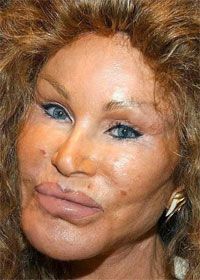
Botox, which has it’s origins in the bacteria, Clostridium Botulinum, is used commercially in medicine, cosmetics (as can be seen in the picture above – where it’s been extensively used), and research.
Infection with this type of bacteria causes the disease botulism, which can be fatal.
Botulinum toxins are classified into type A and B, both of which affect the nerve endings – by blocking the conduction of nerve impulses.
The effects of administered botulinum toxin (Botox) do wear off, depending on the dose, site of use and the nature of the underlying condition needing its use.
It is important to note that there are a variety of products of Botox and that the units for one product are not the same as that of another unit in terms of activity. This can lead to drug errors if not taken into consideration.
There is professional regulation about who can give treatment, as given in this General Medical Council reference (http://www.gmc-uk.org/publications/29030.asp).
Botox is used therapeutically in the following conditions:
Neurological conditions:
· Cerebral palsy- to reduce increased muscle tone in limb that is ‘tight’, i.e. showing signs of spasticity
· To help with the management of increased tone in the upper limbs +/- lower limb spasticity following stroke
· The management of spasm in the face, e.g. hemi facial spasm where half of the face in involved. Similarly, the eye may be involved, giving rise to spasms of the eyelids (blepharospasm) and where there are spasms of the neck muscles, causing torticollis
· Assisting with the management of chronic migraine (when there are at least 15 days per month with headache, during which 8 days or more are associated with migraine)
· Bladder dysfunction not controlled by medication, such as an overactive bladder, or increased activity of the area of the bladder associated with urinary incontinence (neurogenic detrusor over activity)
· Excessive sweating in the armpits (hyperhidrosis), furrowing of the lines of the forehead between the eyebrows+/- crow’s feet
Treatment Failure
It can take up to a month to establish if there has been no response following the administration of Botox.
Confirming that there has not been a response includes muscle/nerve conduction studies (when used in muscle groups) and the underlying reasons for the expected results not occurring must be sought, e.g. insufficient dose/incorrectly reconstituted Botox, or in some cases after previous Botox administration, the development of antibodies to Botox, in effect, neutralizing the neuromuscular blockade that Botox usually produces.
Contraindications
Botox should NOT be used in the following situations:
· known hypersensitivity to botulinum toxin
· infection at the intended injection site
In the management of bladder disorders, the following are also contraindications to Botox’s use:
· urinary tract infection
· current acute urinary retention patients not routinely catheterised
· unwilling patients or those who can initiate catheterisation post-treatment
· bladder stones
There are certain disease specific conditions, such as those where there is an abnormality of the neural muscular junction, as in myasthenia gravis or Lambert-Eaton syndrome. In these conditions the risk of sustained spasticity in the affected part of the body occurs when Botox is given.
Adverse Events
Side effects can occur even if previous injections had been tolerated without any problems, so for each subsequent administration of the botox, the patient should be advised about problems to look out for and about when to seek help.
The following side effects are associated with Botox injection:
Potentially severe outcomes:
· Difficulty Swallowing
· Drying and Inflammation of Cornea and Conjunctiva of Eyes
· Muscle Weakness
· Poor Eyelid Closure
· Voice Disorder
Less severe outcomes
· Pain, swelling or infection at the injection site.
· Accumulation of Fluid in the Tissues of the Eyelid, drooping of the eyelid,
· Irritation of the eye
· Nose, Throat or Sinus acute infections
· Dry Mouth
· Nose bleeds/inflammation of the nasal passage
· Increased liability to influenza infection
· Cough and throat irritation
· Inability to Empty Bladder
· Painful Urination
· Urinary Tract Infection
Medicolegal Problems
Botox use has increased dramatically over the past 20 years, with the majority of its use being for cosmetic purposes. As it may take about 3-5 days for the botox to start to work, people may consider wrongly that there has been a failure of it to work. Rubbing the botox may spread it and lessen the intended local effects.
Complaints also arise as it lasts (for intramuscular injections) for about 3-5 months with the effects increasingly diminishing with each subsequent dose in a number of patients.
It should not be given to pregnant or breastfeeding women as the features of the drug are not understood in this population.
As indicated, the incidence of adverse events is, on the whole, uncommon but the treatment should be given by trained personnel with the drug being prescribed by a regulated healthcare practitioner such as a doctor, dentist, nurse or pharmacist prescriber. Any such practitioner must examine the patient prior to administration – there has been a case where the doctor prescribed botox for a nurse to give without having examined the patient – he was subsequently suspended from practicing for 12 months.
If you want further information about this particular topic, or wish to discuss the possibility of bringing a claim for Clinical Negligence - or indeed any other type of injury, please contact the Dutton Gregory Clinical Negligence Team on (01202) 315005, or email k.marden@duttongregory.co.uk
NB This article does not constitute legal advice and should not be relied on as such. No responsibility for the accuracy and/or correctness of the information and commentary set out in the article or for any consequences of relying on it, is assumed or accepted by any member of Dutton Gregory LLP.






